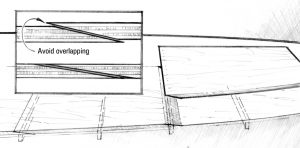Scarffer
Scarffer circular saw attachment
The Scarffer is a unique tool designed by boatbuilders for cutting accurate scarf joints in plywood up to 3/8″ thick. It attaches easily to most circular saws and is easily removed. The saw must have a base plate extension (outside of the blade) ½” or wider
875 Scarffer® 1 ea. (saw not included)

Making Scarf Joints with the Scarffer
The 875 Scarffer circular saw attachment is ideal for working with plywood up to 1/4″ (6 mm) thick, and with minor hand finishing may be used on panels up to 1/2″ (12 mm) thick. Bevels cut with the 875 Scarffer attachment can be more accurate than hand-cut joints, especially if you have little experience making scarfs by hand.
Although there are several different kinds of scarf joints, we advocate using the simplest and most reliable approach, fabricating identical bevels at the ends of the pieces of plywood to be joined. Dry fit these matching bevels, and then permanently bond them with WEST SYSTEM® Epoxy. In many boatbuilding situations, we recommend a ratio of 8-to-1 to determine the size of the bevel. For example, when using 1/2″ (12.5 mm) plywood you need a 4″ long bevel.
The advantage of scarf joints is that they are strong, lightweight, and reduce stress concentrations. In demanding situations, extra strength can be gained by increasing the length of the scarf and they are even less likely to produce a hard spot that could result in an uneven surface when bent. The disadvantage is that fabricating a scarf joint will take more time and skill compared to the butt block and also reduce the length of the plywood.
For making a scarf joint by hand, the basic tools require a block plane and a smoothing plane. Using a power plane or belt sander can save a lot of time in roughing the scarf bevel down close to its intended dimension, but without this luxury use a smoothing plane with a sharp, deep-set blade to remove a majority of the stock as quickly as possible. Then use a more finely set block plane to finish off the scarf bevel, being careful to keep the bevel straight and flat as you proceed. For best results keep the plane blades sharp at all times.

You can save a good deal of time when hand beveling by setting up several panels in a stack for simultaneous block planing. For instance, assume that you want to plane bevels on four 1⁄4″ panels all at once. Draw 2″ bevel lines, which represent 8-to-1 bevels, across all the panels. Stack all four of the panels on top of one another on a flat table. Place the edge of the bottom panel flush with the edge of the table. Then place the second panel with its edge matching the bevel line of the first panel, and the third panel with its edge matching the bevel line of the second panel, and so on. Clamp the whole stack to the table and plane one continuous bevel over all of the panel ends.—Excerpted from Joining Plywood by Don Gutzmer, Epoxyworks 46
